
Paul Matschie was a German zoologist.

The Natural History Museum is a natural history museum located in Berlin, Germany. It exhibits a vast range of specimens from various segments of natural history and in such domain it is one of three major museums in Germany alongside Naturmuseum Senckenberg in Frankfurt and Museum Koenig in Bonn.
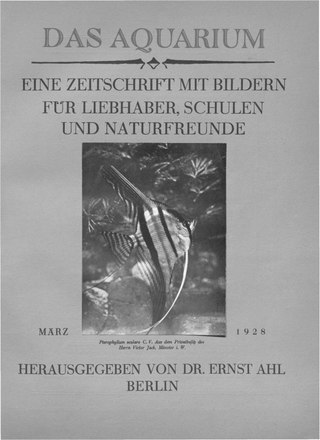
Christoph Gustav Ernst Ahl was a German zoologist, born in Berlin.
Zanclodon is an extinct genus of archosauriform from the Erfurt Formation in southern Germany. It was once a wastebasket taxon until a taxonomic revision by Schoch (2011) left only the paratype within Zanclodon laevis proper. The type species is Z. laevis.
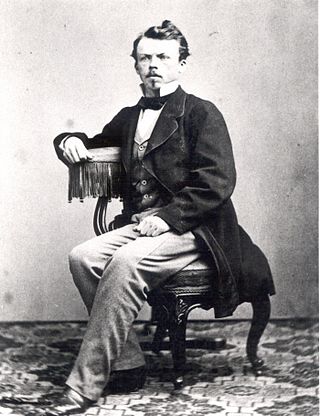
Carl Albert Oppel was a German paleontologist.

Termatosaurus is a potentially dubious genus of archosaur known from several tooth specimens. Its remains come from the Upper Triassic of France, England, Germany and Switzerland.

Stenopterygius is an extinct genus of thunnosaur ichthyosaur known from Europe.
Californosaurus is an extinct genus of ichthyosaur, an extinct marine reptile, from the Lower Hosselkus Limestone of California, and also the Muschelkalk of Germany.

Julius Weise was a German entomologist. He specialised in Coleoptera, especially Chrysomelidae and Coccinellidae, and was one of the first entomologists to use genitalia to identify and classify species.

The swift fruit bat is a species of megabat in the family Pteropodidae.
Erich Martin Hering was a German entomologist.

Leptonectes is a genus of ichthyosaur that lived in the Late Triassic to Early Jurassic. Fossils have been found in Belgium, Germany, Spain and the United Kingdom. A possible specimen from Switzerland first reported in 2006, has been reclassified as that of Hauffiopteryx. The type species, L. tenuirostris, reached 4 metres (13 ft) long, while L. moorei reached 3 metres (9.8 ft) long; the largest species, L. solei, was approximately 5–6 metres (16–20 ft) long.

Hydrorion is a genus of plesiosaur from the Toarcian Age of the Lower Jurassic. It is only known from multiple specimens, all discovered in the Posidonia Shale of south-western Germany. The only species of Hydrorion is H. brachypterygius, which was originally described as a species of Plesiosaurus and then Microcleidus. It was a relatively small plesiosaur, with the largest specimen measuring 4 m (13 ft) long.

Albertoppelia is an extinct genus of prawn which existed during the Late Jurassic period, named after Albert Oppel. It contains the single species Abertoppelia kuempeli. Fossils of Albertoppelia were recovered from the Eichstätt Formation in Bavaria, Germany.

Koelga is an extinct genus of prawn in the order Decapoda. It contains the species Koelga curvirostris and Koelga muensteri.
Buergerocaris is an extinct genus of shrimp, containing only one species, Buergerocaris psittacoides.
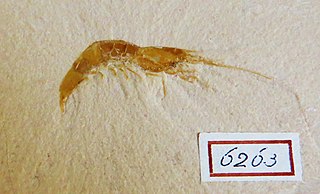
Hefriga is an extinct genus of shrimp in the order Decapoda. It contains three species, and lived in the Jurassic period.
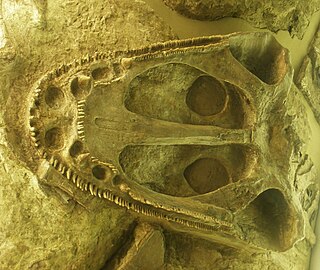
Heptasaurus is an extinct genus of Triassic capitosaurian temnospondyl within the family Mastodonsauridae.
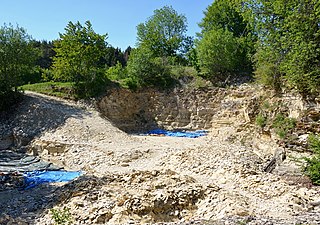
The Nusplingen Limestone is a geological formation in Baden-Württemberg, Germany. It preserves fossils dating to the Kimmeridgian age of the Late Jurassic. It mainly consists of lithographic limestones deposited in a marine basin, similar to the Solnhofen Limestone. Fossils of pterosaurs, thalattosuchians, and the oldest geophilomorph centipede Eogeophilus were found in the Nusplingen Limestone.
Eogeophilus is an extinct genus of geophilid centipede that was discovered in the Nusplingen Limestone of Germany. It is a monotypic genus, with only type species Eogeophilus jurassicus known.














